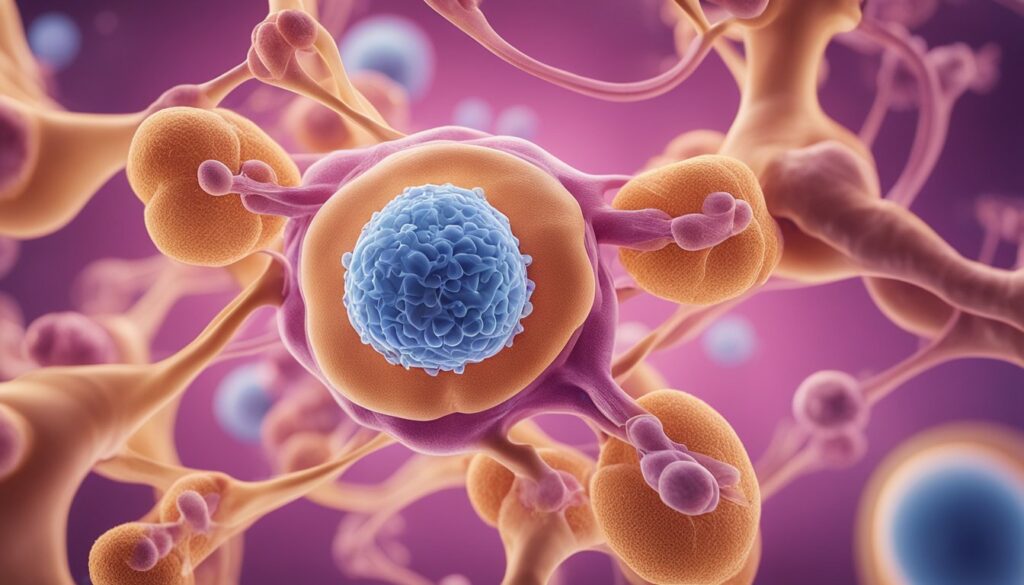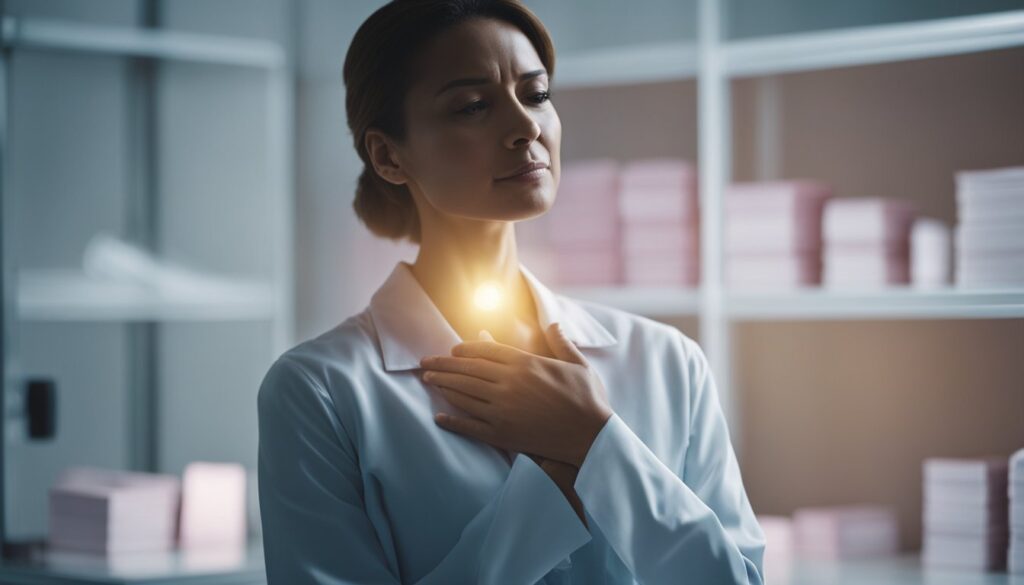Fibrocystic breast disease is a non-cancerous condition that causes lumpy and often tender breasts. It’s one of the most common types of benign breast issues. Many women go through fibrocystic changes at some point, with symptoms that can range from mild to severe discomfort, usually linked to their menstrual cycle. This common condition involves lumps or thickened areas in the breast, which can sometimes be mistaken for more serious issues.
Understanding fibrocystic breast disease is important for recognizing it. Symptoms may include breast pain, tenderness, and movable lumps often felt near the armpit. These symptoms can get worse just before your period and might come with nipple discharge that is usually clear or slightly cloudy.
Because fibrocystic breast changes are so common, they are the most frequently diagnosed benign breast condition among women worldwide. To diagnose fibrocystic breast disease, doctors typically perform a clinical exam and may recommend mammograms or ultrasounds to rule out other problems. Managing this condition effectively involves keeping track of your menstrual cycle and being aware of any changes in your breast tissue. If you notice sudden changes or have ongoing pain, it’s important to see a healthcare provider for a thorough check-up.
It’s also crucial to know the risk factors for breast cancer while dealing with these symptoms since fibrocystic changes can sometimes make it harder to assess breast health.
Understanding Fibrocystic Breast Disease

Fibrocystic breast disease is a common condition that causes lumpiness and discomfort in the breasts. Knowing what fibrocystic breast disease is can help you manage its effects better. This condition often includes symptoms like breast pain, swelling, and changes in texture.
Causes of Fibrocystic Breast Disease
To understand fibrocystic breast disease better, it’s important to know its causes. Hormonal changes, especially those related to the menstrual cycle, are a big factor. Conditions like Polycystic Ovary Syndrome (PCOS) can also lead to these symptoms. These hormonal fluctuations often result in various breast changes that may be mistaken for more serious conditions.
Management Options for Fibrocystic Breast Disease
For managing fibrocystic breast disease, doctors may recommend treatments like progestin and anti-estrogens. Regular mammograms and ultrasound are also important to distinguish between fibrocystic changes and other breast issues like fibroadenomas or even breast cancer.
By learning about these points, you can handle the challenges of fibrocystic breast disease more effectively.
Definition and Symptoms
Fibrocystic breast disease, also called fibrocystic breast changes, is a non-cancerous condition where your breasts feel lumpy or rope-like due to hormonal changes. As a woman, you might notice these changes as part of your body’s normal reaction to hormones during your menstrual cycle. Common symptoms include:
- Breast pain or tenderness
- A feeling of fullness or heaviness
- Cystic changes: fluid-filled cysts that may change in size
- Variable lumpiness in breasts: lumps or thick areas that can often be felt around the ducts and lobules of breast tissue.
Symptoms may get worse before your period due to hormonal effects and usually improve after it starts. Knowing the causes of fibrocystic changes can help you tell them apart from more serious issues, making it important to consider testing if you notice significant changes in your breast health. Some women may also find relief from severe breast tenderness with medications like tamoxifen, which can help manage hormonal fluctuations.
Causes and Hormonal Influence
We don’t completely understand what causes Fibrocystic Breast Disease, but it’s closely related to changes in hormones in your body. Estrogen and progesterone, important female hormones, have a big impact here. Throughout your menstrual cycle, shifts in these hormone levels can lead to changes in breast tissue, causing the symptoms linked to fibrocystic breasts.
Hormonal Influence
Higher levels of estrogen and progesterone just before your period can increase breast tissue density and lead to cyst formation due to their effects on fibrocystic breast disease.
Breast Composition
Your breasts are made up of lobules (glands that produce milk), ducts (tubes that carry milk), and fatty and fibrous tissues. It’s important to understand how estrogen and progesterone affect these tissues since hormonal changes can lead to fibrocystic alterations.
Recognizing these hormonal factors helps distinguish between normal changes in breast tissue and symptoms that might need a doctor’s attention for further evaluation and treatment. A team approach in breast care can be helpful in managing the complexities of conditions like Fibrocystic Breast Disease.
Diagnosis and Management

When addressing fibrocystic breast disease, it’s important to conduct a detailed clinical evaluation to exclude other conditions. This often involves tests like mammograms and ultrasounds.
The main goal of management is to relieve symptoms and keep breasts healthy while making sure patients understand that these conditions are not harmful.
If more investigation is necessary, various biopsy methods such as fine-needle aspiration, core needle biopsy, and excision biopsy may be used to confirm the diagnosis of fibrocystic breast disease.
Clinical Evaluation and Diagnosis
Your doctor will start with a clinical breast exam to look for any lumps or unusual changes in the breast tissue. This exam is an important part of breast cancer screening. If more checks are needed, tools like mammography or ultrasound may be used. A mammogram is an X-ray of the breast that helps find breast cancer, but sometimes dense tissue or cysts can make it tricky to read.
An ultrasound is better at telling apart solid lumps from fluid-filled cysts, which helps determine if a lump is harmless or something more serious. If something concerning is found during these tests, a biopsy might be needed. This can be done in different ways, such as fine-needle aspiration (FNA biopsy), core needle biopsy, or excision biopsy. These procedures are key to figuring out if the issue is benign or if it could be breast cancer, allowing for a clear understanding of benign vs malignant breast conditions.
It’s also important to think about risk factors for benign breast issues when talking about symptoms and treatment options, especially for those with concerns like fibrocystic changes. Treating fibrocystic breast disease might involve lifestyle changes and medical treatments based on the findings from these diagnostic tests.
Treatment Options and Lifestyle Changes for Fibrocystic Breast Disease
For fibrocystic breast disease, treatment mainly focuses on relieving symptoms. Over-the-counter pain relievers like acetaminophen or non-steroidal anti-inflammatory drugs (NSAIDs) can help reduce pain and discomfort. Wearing supportive bras or sports bras can also make you more comfortable, especially during exercise.
Some people find that taking evening primrose oil or vitamin E helps, but it’s important to talk to your healthcare provider before trying any new supplements. Cutting back on caffeine may also help ease symptoms for some women.
If symptoms are more severe, doctors might suggest hormone therapy, such as birth control pills, danazol, or tamoxifen. However, these medications may have potential side effects, so it’s crucial to discuss the pros and cons with your healthcare provider.
Your treatment plan will be tailored to your specific symptoms and medical history. Regular check-ups and being aware of any changes in your breast tissue are important for managing this condition.
Frequently Asked Questions about Fibrocystic Breast Disease

In this section, you’ll find clear answers to common questions about the symptoms of fibrocystic breasts, what causes these changes, and how doctors diagnose the condition. It’s important to understand how hormones affect breast health when looking into ways to manage breast pain related to this issue. We will also talk about how biopsies help diagnose different breast conditions.
What are the common symptoms of fibrocystic breast changes?
Common symptoms of fibrocystic breast changes include breast pain before your period, which many people feel because of hormone changes. You might also find lumpy areas in your breasts, especially movable lumps near the armpit. These changes can be normal, but if you’re looking for information about breast symptoms, it’s important to talk to a healthcare professional.
Regular breast exams are important for checking any major changes and ruling out issues like breast cancer. If you’re having ongoing discomfort, you might try self-care methods for breast pain such as warm compresses or over-the-counter pain relievers. Also, discussing possible treatment options for fibrocystic breast changes with your doctor can help manage your symptoms effectively.
How do hormonal changes affect fibrocystic breast condition?
Hormonal changes, especially during the menstrual cycle, greatly impact breast tissue health and are key in causing Fibrocystic Breast Disease. These changes can lead to symptoms like swelling and tenderness in the breasts, often resulting in discomfort or pain.
Knowing how the menstrual cycle influences breast tissue is important for identifying signs of fibrocystic breasts and exploring appropriate treatment options.
Can changing your diet help with fibrocystic breast disease symptoms?
Altering your diet, like reducing caffeine and changing how much fat you eat, might help lessen the symptoms you feel during your menstrual cycle if you have fibrocystic breast disease. Some studies suggest that these dietary changes can improve breast health, but it’s still not clear how effective they really are.
Why is ultrasound important for diagnosing fibrocystic breast changes?
Breast ultrasound is important for diagnosing fibrocystic breasts because it helps tell the difference between solid lumps and fluid-filled cysts. This imaging technique provides clear details about the nature of breast lumps, which helps doctors make accurate diagnoses when checking for breast issues.
Can some hormonal birth control make fibrocystic breasts worse or cause them to develop?
Some hormonal birth control methods may influence changes in breast tissue, raising questions about their effects on fibrocystic breasts. The relationship between hormonal birth control and fibrocystic breasts varies from person to person. It’s important to discuss this with your doctor to understand the possible risks and benefits, especially if you have concerns about Fibrocystic Breast Disease.
Are there natural remedies that can help with cysts from fibrocystic breast disease?
Although there’s no scientific proof, some natural remedies like vitamin E and evening primrose oil are thought to help manage symptoms of fibrocystic breast disease. Vitamin E is often suggested for breast health because it may ease discomfort linked to this condition. Evening primrose oil might also reduce breast tenderness and pain. However, it’s essential to talk to your doctor before trying any new treatment.